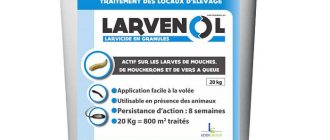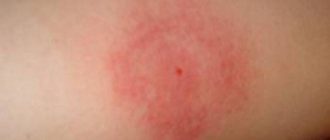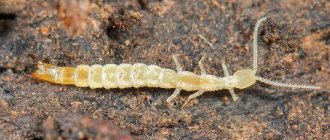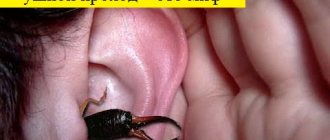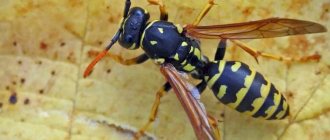Why is it dangerous for humans?
The appearance of a double-tail makes a person panic, especially if he does not have truthful information.
As a rule, there are rumors that this living creature climbs into a person’s ear at night, bites through the eardrum and penetrates the brain. This statement is far from reality, since the insect practically does not attack a person, and can bite only for the purpose of protection.
Even if, somehow, an insect gets into a person’s ear, there will be no harm from it and it won’t just gnaw on the eardrum. The human brain is not the earwig's target.
Out of ignorance, people are afraid that this insect will sting painfully with its powerful appendages. But you shouldn’t worry or panic, despite the terrifying appearance. The bite of the doubletail can be problematic for people prone to allergies. For people whose body responds adequately to the bites of various insects, a forktail bite does not pose any danger.
A Bashkir pensioner has been living with two tails in his head since September 2021
Watch this video on YouTube
Are earwigs dangerous to humans?
In addition to the “earwig” or “two-tailed insect”, this insect was called by some peoples “earworm” or “ear gnawer”. Scary stories about this insect, passed from mouth to mouth, make people believe that this insect is very dangerous. The most common stories you hear are that earwigs crawl into people's ears while they sleep, gnaw through their eardrums, and can burrow into their brains.
Fortunately, this is a myth that has no scientific basis. The name "earwig" was actually given based on the similarity between the insect's hind wings and the structure of the human ear.
With their intimidating pincers protruding from their abdomens, earwigs can appear like dangerous insects, and many wonder, can earwigs bite? As mentioned above, pincers are used for defense, and if startled or pinned down, an earwig will use the pincers to defend itself. However, these are not bites as such and cannot be compared to the bites of insects with a sting or biting mouthparts.
Earwigs cannot really sting, since they do not have a sting and do not have any poison. As for pinching with claws, they can sometimes be painful, especially if it is pinched by a male with developed cerci. The very act of pinching with forceps may cause some discomfort, but nothing more. However, in some cases the skin may be damaged to the point of bleeding.
If there is a wound left after an earwig attack, it is better to treat it like any scratch. This is due to the fact that earwigs live in soil, and microbes with soil particles can get into the wound. You can use an antibacterial cream or spray to disinfect. There is usually no need to see a doctor, as earwigs do not spread disease and such lesions do not cause allergies.
So, there is no need to worry about earwigs getting into the ears, laying eggs there, or burrowing into the brain, this is not true and such phenomena have not been recorded. Perhaps the biggest threat earwigs pose to garden plants is that these insects love to eat plant parts.
Earwig in the garden
General value
According to the dream book, double tails are a contradictory symbol. The main interpretation of an unsightly creature is hypocritical behavior, blatant lies
Moreover, what has been said can relate both directly to the observer and to his immediate, especially important, surroundings
Other transcripts are less common. The two-tailed thing that appears in a dream means:
- Problems with the kids. Images of earwigs are often interpreted as childish. The sleepy destruction of creatures is a projection of the observer’s real hostility towards his own offspring;
- Minor, but extremely troublesome troubles. In the dreamer’s life, a huge pile of unresolved problems grows, leading to depression and uncertainty;
- Future diseases, disorders, physiological troubles. A positive sign is the complete destruction of two-easts: in reality you will be able to quickly recover;
Listen to your intuition. A premonition will indicate the meaning of the subconscious image and will help you correctly interpret what you see.
Preventing the appearance of double tails in the house
So that the earwig forever forgets the way to the house and does not appear again:
- you need to find and destroy its nests, you should look under the floor, in cracks in the walls, insulation, under baseboards, in a word, in all the cracks where moisture can accumulate;
- the egg laying must be destroyed, and the affected materials must be replaced with new ones.
- since the insect lives in places of high humidity, it is necessary to eliminate the possibility of the formation of a favorable environment for its habitat in the home;
- carry out repair work to eliminate dampness in residential premises: thermal insulation and waterproofing of walls and basements;
- regular ventilation of premises;
- during cool periods, thoroughly heat the home;
- It is better to dry clothes outside or use electric dryers;
- do not leave taps open;
- prevent pipes from leaking;
- Moisture absorbers will help cope with high humidity;
- do not leave leftover food, take out the trash regularly;
- In summer, put a net on the windows.
If all the methods and methods turned out to be insufficiently productive, then high-quality repairs will help get rid of the two-way, and the sanitary and epidemiological station will carry out a thorough treatment.
Every spring, residents of private and apartment buildings, summer residents living in summer houses, are puzzled by the question of how to get rid of double-easted hair forever. The problem is serious. Insects are very unpleasant. They spoil life no less than cockroaches and household ants. It's difficult to get them out.
Whom to fear?
It happens that the double-tailed fish is dangerous for humans
The exciting question of whether a double-tailed snake can bite a person can be answered positively if a puncture of the skin is mistaken for a bite. In appearance, these are harmless arthropods of small size (from 2 to 5 mm), eyeless, faceless. Equipped with pigmented cerci. They are considered the main weapon of revenge. Thread-like or claw-like cerci are clearly visible on the ventral part. Two-tails live in damp places. Kitchens, bathrooms, and basements fit this description, as do damp piles of leaves and humus bedding.
What is a double tail?
Double-tailed - this is how the insect was popularly called because of the strong chitinous outgrowths instead of a tail, called cerci. The correct term is earwig or forktail. It has an oblong segmented body of brown-red color with six legs. There are no eyes, and long antennae are located in front, reaching half of the insect's body.
It also has small wings, but the forktail rarely uses them and flies only short distances. Usually its size is modest: 2 or 3 cm, but there are also larger individuals that grow up to 7 cm. The cerci of all varieties are different: in medium-sized specimens they are small and relatively thin. The large ones have hard, powerful, claw-like claws, with which the two-tailed fish hunt springtails and small soil mites.
The doubletail settles in damp and cool places; it loves holes with humus. Two-tailed ducks are extremely agile and dexterous, move very quickly, hunt at night, not one at a time, but in flocks. Their diet is varied, the predator looks for larvae of small insects, microscopic mites and centipedes. He will not refuse the shoots and inflorescences of plants, fruits, vegetables, and will not disdain bread crumbs.
Penetrating into a living space, it hides in damp nooks, crevices between baseboards, boards, cracks in walls, and in the basements of houses. In apartments it hides in bathtubs and rooms with poor ventilation. Her presence in the house is not always immediately noticeable, because she goes out hunting at night and hides during the day.
Description of the earwig
The insect has a small, long brown body with two impressive claws in the tail area. When in danger, it stands on its front legs, bends strongly, lifts its tail and exposes its cerci, while secreting an odorous substance. All this makes her look like a poisonous and terrifying scorpion. In fact, the earwig needs such a tail to hunt and hold small insects and larvae on which it feeds, and for protection.
Also, some species have underdeveloped wings on their bodies, which are securely hidden under hard wing covers, but they are not suitable for full flight; if earwigs fly, then in extreme cases they fly very ineptly. The insect prefers to be active at dusk and at night, but during the day it hides in dark and damp places. Earwigs live in groups, and in wetlands there can be incredibly many of them.
How to deal with earwigs
The fight against earwigs in the garden and garden involves, first of all, putting things in order. There should be no compost heaps, various rubbish, etc. in the garden. In addition, many pesticides serve as an excellent means of destroying earwigs.
Controlling earwigs in a greenhouse requires a more careful approach. Cleanliness and order are also the main requirement. In the greenhouse, you can place flower pots upside down and pour some oats or other bait inside. It is advisable to grease the inside of the pots with oil. I get inside, the earwig has no way to get out. Next, the pots must be destroyed along with the earwigs or thrown away.
Earwig and how to deal with it
One of the folk remedies for controlling earwigs in the area is spraying the soil with a tincture of onion and garlic. Such a harsh mixture repels insects.
Earwig in the apartment and house
Earwigs in the house are extremely unpleasant neighbors. They have an extremely unpleasant appearance. Don't try to catch them with your hands - they can bite quite painfully. Earwig bites can cause infection and infection, so be careful. If there is a bite, treat it with alcohol and consult a doctor.
Usually, earwigs do not live in houses, but if the room is damp and dirty, they can feel quite comfortable in it.
Earwig in the apartment
In addition to the house and garden, the earwig can choose a barn or garage as its habitat. To get rid of earwigs in your garage and shed, you need to seal all the cracks in them. The control method using boric acid will also be quite effective. But, it must be taken into account that earwigs should not have access to water. Otherwise, boric acid will be ineffective. You can also use various household poisons against insects, such as dichlorvos. You can also treat the room with vinegar - after using it, earwigs simply will not be able to live there. After treatment, the room should be closed for several days. After baiting, ventilate thoroughly.
// ]]>
Myths and facts about earwigs
- There is a myth that an earwig can get into a sleeping person's ear and damage the eardrum. This myth is completely unfounded. Earwigs avoid unnecessary attention to themselves in every possible way. This situation is only possible if a person crushes the earwig with his ear in a dream and it has nowhere to go.
- Only a few species of earwigs are able to fly, and over extremely short distances.
- No species of earwig is venomous, but all of them can bite painfully.
- During winter, earwigs burrow to a depth of ~2m to access groundwater.
Preventive measures
Forktail does not tolerate onion and garlic smells
In order not to wonder whether the two-tailed dog can crawl into your ear or bite, take measures to prevent its appearance in the apartment and private house. Prevention is also relevant because using insecticides in residential areas to control insects is very risky.
- Take care to exclude ways for the forktail to enter your home: caulk windows, eliminate cracks, adjust door frames, window openings through which the insect can enter the house.
- Eliminate the source of moisture that creates excessive dampness: inspect the shut-off and distribution valves, eliminate leaks.
- If possible, light dark places in the room.
- Ensure sufficient air exchange rate to eliminate dampness.
- Treat the outside of pots with house flowers with vinegar: the two-tailed plant, which feeds on rotten remains, cannot tolerate the pungent smell of acid.
- You can use crayons and gel-based preparations. Constantly update them in places where there is a possibility of insects entering the apartment.
- Place piles of quicklime under cabinets, beds, and cabinets.
- If the cracks are not sealed, use Dichlorvos or Karbofos, and near the baseboards it is better to pour “paths” of boric acid or lay out acid balls (boric acid mixed with egg yolk). But the “acid attack” will be ineffective if there is a source of water nearby.
- The pungent smell of onions and garlic repels forktails. Therefore, prepare a garlic-onion water tincture from 100 g of crushed ingredients. 200 g of raw material is filled with 0.5 liters of water. After 24 hours of exposure, wet walls and dark rooms (including basements) are treated with the strained mixture. The effectiveness of the method increases during the period of activity of the two-east - in spring and autumn. Treatment at this time is carried out once every week.
If the fear of the two-tailed arthropod has not disappeared, and you cannot get rid of the two-tailed arthropod on your own, contact the disinfection department of the sanitary service.
Check out articles on similar topics
- The earwig and how it is dangerous for humans
- How to get rid of a butterfly and its larvae
- How to get rid of the borer beetle and its larvae
- How to deal with woodlice in an apartment and how to poison the insect
Comments
leave a comment
Giant earwigs
The largest representatives of this species - giant earwigs - live only on St. Helena Island. First discovered in 1798, they were considered an extinct species for a long time after rats appeared on the island from a stranded ship in 1918. They were rediscovered in 1950 and 2001. Attempts to find them in 2003 and 2004 were unsuccessful.
Giant earwigs photo
Giant earwigs reach 8 cm in length and are black in color. The giant earwig is listed as a critically endangered species on the International Red List. This situation arose due to deforestation in their habitat, as well as the fact that centipedes Scolopendra morsilans were introduced to St. Helena Island, which became a more successful competitor in this food chain. Giant earwigs live in deep holes and crevices and only come to the surface at night after rain.
Earwigs breed in late summer and early autumn. The fertilized female digs a small tunnel in the ground and lays eggs. At one time, the female can lay up to 50 eggs. The female overwinters in the same burrow, protecting the offspring, positioning herself so as to cover the clutch. Males often do not survive the winter, so their remains can be found in such burrows. For some time after the birth of the offspring, the female remains with him, protects and feeds him. After the death of the mother, the larvae begin to live and feed independently.
Male (left) and female (right) earwigs. Males are usually larger and have curved pincers.
Earwigs are omnivorous insects. They have earned a bad reputation as garden pests because they can damage plant leaves, eat young shoots of plants, and gnaw flowers. Insects are nocturnal. During daylight hours, they hide in damp and dark places, cracks in houses, compost heaps, etc. The insects are incredibly nimble.
Can earwigs harm indoor plants?
Earwigs can enter human habitation on their own in search of food or due to changes in weather, getting inside through open doors. Because earwigs prefer cool, damp places, they are most likely to enter homes during long dry periods. You can also accidentally bring an earwig into the house on your own when, in the autumn, the queen cells are brought indoors for the winter. In this case, insects can hide in the soil inside the pot, or hide in a saucer under the container.
For a prosperous existence, earwigs need a constant positive ambient temperature, a substrate with a high moisture content and food, which, in principle, provides the room where indoor flowers are kept. Therefore, insects, once in the house, can remain there for a long time.
During the daytime, earwigs are usually found under flowerpots in saucers that are used to collect water under the containers, as this is a damp, dark place out of the sun. Earwigs can feed on rotting vegetation washed through the humus soil in the bottom layer of potting soil, but this may not be enough for them and earwigs may attack young houseplants and especially seedlings.
If it turns out that earwigs live in flower pots, then remove the plant and shake out the insects outside, replant the flower in fresh soil, check the saucers and soil of other indoor plants for the presence of other earwigs or eggs and remove if found. Also, in a room where earwigs have been found, turn over and inspect the edges of the carpet to make sure there are no insects hiding there. If found, they can be removed with a vacuum cleaner and the dust bag shaken out outside the house.
Earwigs can attack young indoor plants and especially seedlings. © naturgucker
Economic importance of earwigs
Earwigs, being a small group of insects in terms of the number of species, have relatively little economic importance compared to the rest of the order complex. However, this group still includes a number of species that have a certain and sometimes very significant economic importance for individual crops and economically valuable plants.
The most significant role is played by 3 types of earwigs - the Asian earwig, the garden earwig and the common earwig. As for the first species, it is a pest of the seeds of the wild rubber plant - tau-sagyz in the Karatau mountains in southern Kazakhstan, which is currently a significant source of seed products necessary for planting plantations of this very valuable rubber plant. The harm is expressed in the gnawing of stigmas and pistils in flowers or sometimes in the complete eating of ovaries in young buds.
The garden earwig, on the contrary, is an extremely polyphagous pest, which is especially significant for garden crops (potatoes, beets, soybeans, poppy seeds, sunflower seedlings, cabbage, tomatoes), as well as for melons (cucumbers, pumpkins, melons), tobacco and floriculture, causing damage both in the larval and adult states by gnawing leaves, gnawing stems, or even completely consuming seedlings and young plantings. In addition, this species is noted as a pest of sugar beet seeds in Ukraine, gnawing out semi-ripe seeds. Climbing into weak apple fruits, the earwig can also cause some, but insignificant, harm.
The common earwig harms garden plants and floriculture in Ukraine and Western Europe, eating living leaves, flowers and semi-ripe seeds. In addition, this species is important for corn and other cereals (semi-ripe seeds are eaten) and fruit trees. Having been introduced to North America, the common earwig species even became a quarantine object due to the severe damage it caused to nurseries of ornamental and other trees. In New Zealand, where this species was also introduced, it became the scourge of local fruit growing. In addition, there have been cases of this type gnawing out passages in baked bread.
From all this it should be concluded that the order of earwigs is not a group of insects indifferent to humans. Their economic importance can sometimes be so significant that the absence of certain control measures can jeopardize the yield of damaged crops.
Symptoms of an insect in the ear
So the symptoms show themselves as follows:
- Attacks of acute pain and unpleasant sensations reminiscent of tickling inside the ear.
- The patient feels congestion in the ear canal and a decrease in the level of hearing.
- Attacks of dizziness and mild nausea, and in particularly susceptible patients the gag reflex is a consequence of irritation of the nerve endings located inside the ear.
- If living creatures emit chemical or other biological, irritating compounds, swelling, necrosis of the dermis, and, less often, bleeding caused by bites are possible.
- Inflammation occurs very rarely - it is more likely a consequence of complications, as well as the manifestation of seizures from irritation of nerve endings.
Description of two-whiskers and earwigs
Diplura are arthropod wingless insects, recently introduced into a separate independent class, which includes subspecies such as projapygidae, campodeidae, and Japygidae. Distributed mainly in the tropical and subtropical parts of the planet. In Russia there are 20-30 species of Campodeidae, in the southern part of the country Japygidae. The average lifespan of the double-tailed insect is 12 months.
Two-tailed insects are small insects.
Appearance: body length 5-7 mm (in the class there are specimens 50 mm long), 6 pairs of legs, absence of eyes, elongated body, rounded head with antennae, the extreme appendages of the last abdominal segment are forked, claw-shaped, or elongated, have the ability to rapid recovery, the oral cavity is hidden inside the head, the color is light.
They choose a habitat with high humidity: rotten trees, forest litter, damp soil, large anthills, plant debris, greenhouses, compost pits.
Their body length is 2-5 mm. There are also larger individuals, the body length of which is 50 mm.
Food: remains of other animals, insects, plant waste, leftover food, fruits, vegetables, shoots and leaves of plants.
Reproduction: the female lays eggs in the soil. Fertilization occurs when the spermatophore enters the female's genital opening. Spermatophores are very tenacious; they can stand on a thin but stable stalk for up to two days, waiting for a passing female. Cubs hatched from eggs differ from adult two-tailed birds only in their smaller size and the absence of genitalia.
They easily enter the house through cracks, open doors and windows.
The common earwig (Dermaptera) is an insect from the order Leatheroptera. There are 1,200 species, distributed on almost all continents.
Earwigs, like all household insects, spread infections and make people's lives worse.
Appearance: flexible, curved body, consisting of 10 segments and a dense chitinous cover. Size: 10-16 mm. The color is brown with a brown or resinous tint. The elongated, jointed body ends with cerci, reminiscent of claws in shape. Three pairs of legs are yellow. There are no eyes. Long multi-segmented mustaches that replace the organs of touch. The gnawing opening of the mouth protrudes forward. Characteristic feature: leathery wings. The anterior transverse ones are compact in size, the rear fan-shaped ones cover the body to the middle of the abdomen. The earwig doesn't fly. With the help of its wings, it can sometimes make long jumps and flights.
It is quite difficult to fight them - they hide well during the daytime.
Habitat: compost pits, heaps of natural garbage, utility rooms with high humidity, old trees, a bathhouse, an outdoor shower, a flower bed.
Food: other insects, rotting crops, leftover food, leaves of garden and garden plants in the country.
Reproduction: incomplete transformation. Mating lasts 6-8 hours. The female climbs and lays eggs in a specially dug hole in the ground. She helps the larvae hatch by gnawing holes in the eggs, then licks them and warms them with her warmth.
Living in a greenhouse or greenhouse in large numbers, these two-tailed creatures cause a lot of problems for those who love gardening.
Other names: European earwig, tick (Forficula auricularia), pincer, two-tailed.
Insects are similar in sting shape, type of nutrition and lifestyle. These predators go hunting at night; during the day they hide in shaded, damp places.
When a person encounters a two-tailed dog, he immediately has associations with painful bites.
Traditional methods
Have you ever had to deal with earwigs?
It happened, it didn't happen
Among the most common ways to combat earwigs is setting traps and treating rooms or areas with a vinegar solution. These products do not directly destroy pests, but help fight them. Insects caught in the trap must be burned. The vinegar solution has repellent properties. Boric acid, which is used to make home remedies for earwig baiting, kills insects.
The earwig does not pose a threat to human health, but it does harm garden and vegetable plants. You need to start fighting it immediately after detection.
Struggle
As mentioned above, earwigs cause damage to our cultivated plants in the garden. And their appearance in the apartment makes you wonder how to get rid of earwigs.
Depending on where you plan to strike your opponent, there are different ways to deal with earwigs.
Garden
If you want to remove earwigs from your garden, you can use the following methods:
- Traps. Place baits in different corners of the site, which you then destroy along with the earwigs. Wet rags, putrefactive plant waste and similar substrates will help attract the two-tailed plant to one place.
- Preventive soil spraying. Not only vampires, but also many insect pests do not like the pungent smell of garlic. Therefore, barrier tillage of the soil with garlic tincture can help against earwigs.
- Boiling water. A large accumulation of double-easted insects is simply filled with boiling water, which kills the insects.
- Vinegar. The sour smell of vinegar also repels earwigs; drip it onto cotton wool or rags and spread it around the area.
Living spaces
In an apartment or other room they act a little differently, because there the concentration of insects is much lower than in the natural environment, although... how to say.
To get rid of uninvited guests, you need to do this:
- Purity. First of all, put the premises in proper sanitary condition and maintain it at all times.
- Lures. Place baits with boric acid inside the room. These can be moistened cereals, boiled egg yolks and the like.
- Vinegar. This is where this earwig repellent will help. Coat your pots with it and keep earwigs away from your indoor plants.
As always, watch the video at the end of the article. This time we present a story about an earwig invasion in Tatarstan.
Controlling earwigs in the garden
Prevention The most important part of controlling earwigs is removing their hiding places so that there is not too much plant debris, boards, downed tree trunks, or anything else left in the area that could serve as a hiding place for them.
If earwigs have already taken a fancy to your garden, try the following remedies:
- Place approximately 20cm long pieces of garden hose in the beds between the plants. Check these traps every morning and shake out the earwigs in a bucket of soapy water.
- To protect large plants, apply petroleum jelly to their stems to prevent earwigs from crawling on it.
- If insects have infested your woodpile, try spraying it with a borax solution, but keep pets and children away from the area afterwards.
- Oil pit traps are also an excellent remedy for earwigs. Mix equal parts soy sauce and vegetable oil in a small plastic container and cover with a lid. Punch holes in the top of the container near the lid to allow earwigs to enter. Bury the container in the soil to the level of the holes. The soy sauce will attract the earwigs, but the oil will keep them from getting out. Change the mixture periodically to a new one.
- Alcohol can penetrate the waxy layer of the insect's integument and kill it upon direct contact with the body. To make an insecticidal spray, mix equal parts 70 percent alcohol and water (or, if using 95 percent alcohol, mix 1 part alcohol to 1 ½ parts water).
- Earwigs are also susceptible to diatomaceous earth (diatomaceous earth is available at garden centers), so you can protect your plants by spreading a ring of powder around the bushes if the soil is dry enough. Diatomaceous earth is not effective in wet weather.
Body structure of the common earwig
The body of the common earwig is dirty yellow, in some cases tar-brown. Antennae 13-segmented, 2nd segment rather long and clearly visible, slightly more than half as long as the 3rd, 3rd segment slightly widened towards the apex, cylindrical, the same length as the 5th, 4th segment short , barely longer than its width, about half as long as the 3rd. The head is rusty brown, sometimes almost or completely black, the seams are very sharp, deeply depressed. The fore-back is almost square, with dirty yellow sides. The posterior margin is moderately rounded. The elytra are dirty yellow, sometimes brownish, with a chopped off posterior edge. The wing plates are quite developed. The abdomen of the common earwig is widened in the middle, slightly tapering towards the apex, with dense, coarse punctures. The pincers are quite strongly flattened, their contacting part occupies no more than one quarter of their length, with a jagged inner edge, gradually tapering towards the middle, limiting the inner sides to an almost perfect circle. The rear end of the expanded part is obtuse-angled, the outer side from the base to the apex is slightly curved, or the pincers are more elongated, near the middle they are curved at a very obtuse angle, the outer sides are parallel to each other, the inner ones limit the rhomboidal space.
Appearance of an earwig
The earwig has a flattened, elongated body. The back color is chestnut brown, the belly color is dark brown. The head is heart-shaped. The antennae on the head consist of 11-14 segments, their length is 2/3 of the length of the body. The eyes are very small. The forewings are short, without veins. The hind wings are membranous, wide, and veined.
During flight, the earwig's body is almost vertical. When the wings are folded, they are tucked under the elytra twice. Earwigs fly extremely rarely, but prefer to use their limbs. The length of females ranges from 12-14 millimeters, and males - 13-17 millimeters.
A notable feature of the earwig is its forked “tail.”
A characteristic feature of earwigs is a pair of pincers on the tip of the body. Both sexes have these forceps, but in males they are larger, have teeth, and are rounded on the inside. In females they are smooth and straight. Earwigs use these pincers to protect and hold prey. If you reach out with your hand towards an earwig, it will raise the back of its body and expose its weapon. With these pincers, she can pierce the skin into blood. But they do not attack people, and sting only during defense.
Myths that shape attitudes
Why are people scared of these insects? The main reason is appearance. Two terrible tails similar to claws, a segmented body, and warning coloring give rise to corresponding associations. In addition, earwigs live secretly, preferring to hide in dark, inaccessible places during the day. An ordinary person, not an entomologist-researcher, has a limited understanding of the habits of two-easted birds, and therefore is based on popular beliefs.
Rumor speaks of these creatures. They say:
- two-tailed cockroaches that can bite painfully;
- they crawl into the ears at night, where they subsequently hatch;
- Living inside the human head, it gnaws its way to the brain.
All of the above is not true, except for the rather noticeable “bites” from the rear “pincers”. Two-tailed is a peaceful creature, causing damage only for the purpose of self-defense. However, the belief that has developed over centuries has formed a negative attitude towards the insect and visions with it.
Who is this two-tailed woman?
Who is two-tailed
They are called double-tailed for their specific appearance - and indeed, in the back of the insect there are two stinger-like tails.
Therefore, they are sometimes colloquially called pincers. Is this why the popular belief began that the double-tailed fish bites?!
First, let's figure it out - the official name of such an insect is the common earwig. It belongs to the order Leatheroptera, has compound eyes, mouthparts directed forward, and a pair of antennae.
Mainly because of its appearance, this insect does not belong to the category of beautiful. Moreover, for many it causes only disgust. That’s why parents often tell their children in childhood that the double-tailed insect bites, so that the child does not reach out to such a creepy insect, and certainly not try to bring such a pet from the street into the apartment.
Does she bite?
But even in adult life, for many, the earwig and its imaginary bites are a vivid example of the proverb that fear has big eyes. It is not uncommon among summer residents and vacationers to hear stories about giant blisters allegedly left on the body of the two-tailed fish, whose bite is described as almost fatal.
If you see the mark from it in the photo, it looks really creepy. But if you delve into the essence of the issue, it actually turns out that in general the double-tailed fish bites extremely rarely and is completely painless.
Attention! And those huge skin lesions that are mistaken for her bite are actually just an allergic reaction to the components of her saliva. Such redness is not uncommon for many people, but all you have to do is contact a specialist and have him prescribe an allergy medication, and the problem is solved.. Earwigs are not predatory insects
Their mouthparts are not designed to bite people. In nature, these insects live in vegetable gardens and are fruit and vegetable pests. They gnaw leaves, fruits, flowers and unripe plant seeds
Earwigs are not predatory insects. Their mouthparts are not designed to bite people. In nature, these insects live in vegetable gardens and are fruit and vegetable pests. They chew leaves, fruits, flowers and unripe plant seeds.
It is also not uncommon for earwigs to live in apiaries or forest hives. There they settle in the space between the walls or in the insulating material of the hive and feed on honey, bees and beebread. This, by the way, is sometimes the cause of a person’s allergic reaction to earwigs.
These insects are predominantly nocturnal. Among earwigs there are several species that are predatory or parasitic, but they are not found in our country. Therefore, if you see this insect, do not be scared and, of course, do not scare children.
Don't try to get rid of it, unless you are "revenge" for a spoiled harvest
Just try not to pay attention to it, drive it off your body if it climbs onto your leg or arm. Remember that the only correct answer to the question of whether double-tailed fish bite is, of course, negative
Description
The earwig is a brown insect with a flat, jointed body 2-3 cm long, covered with dense chitinous plates. Structural features of the earwig: on the tail there are two outgrowths in the form of mites (cerci), hence the second name - two-tailed.
When hunting or in self-defense, it curves its tail and holds its claws above its head, like a scorpion. The shape and size of ticks vary even among individuals of the same species. In defense (earwigs themselves do not attack people), the insect can bite through human skin with them. When hunting, it holds prey with tongs. In males they are larger.
The earwig is often called the two-tailed earwig, but this is incorrect, since the latter belong to an independent order and differ significantly from earwigs.
Ability to fly
Looking at the insect, you would never say that the earwig flies, since the wings are not visible. The front pair of wings is transformed into two short elytra, under which two membranous fan-shaped transparent wings are hidden. Due to this structure of the earwig's wings, they are not visible when folded, but if necessary, they quickly open. The process is similar to the opening of an automatic umbrella or the manipulation of a magician who pulls out a bouquet of flowers from nowhere.
When flying, the insect holds its body vertically.
The unusual body structure of the earwig - wings hidden from external influences, claw-shaped cerci on the tail, flexible jointed body - has helped it survive for millions of years.
Species and distribution
About 490 species have been described - representatives of the order of earwigs, most of which live in southern countries. There are 26 species found in our country. The most common are “Ordinary” (popularly double-tailed), and “Coastal”. “Ordinary” is found everywhere, “Coastal” in the southern part of the country, along the shores of reservoirs, including the Black and Azov Seas.
The latter is larger, has a more intimidating appearance, but rarely settles in vegetable gardens. It is distinguished by its light color and large, sting-like, straight cerci on the tail.
Earwigs: way of life
The insect is omnivorous, feeding on plants and their remains, mushrooms, and other insects. Earwigs live in damp places, under stones, boards and logs, under the bark of old trees and stumps. They live in groups. They become active at dusk and at night (Asian, on the contrary, is active during the day). In apartments, dachas or private houses, it settles in damp places - under bathtubs, in basements.
Earwigs: reproduction
At the end of summer, the female digs a hole in the ground in the form of a tube up to 15 cm long, in which she lays eggs in a heap. Overwinters with them, guarding the nest until the larvae emerge from the eggs. Males usually die in winter. In the spring, young earwigs hatch from eggs, similar to adults, but smaller in size. Earwig development is considered incomplete because they do not go through the pupal phase (incomplete metamorphosis). Insects live for about a year.
Can a double tail crawl into your ear?
To answer your question, you need to know how doubletails reproduce. In order to impregnate a male, the male captures her and holds her with his pincers, injecting his seed into her genitals. Eggs that have already formed in the female's genitals may not be fertilized immediately - the seed can be safely stored in the female's genitals for several months and only then eventually complete its main task of fertilization.
To lay eggs, the female earwig spends a very long time looking for a suitable place for this purpose. Conditions that are guaranteed to be necessary for this include darkness, optimal humidity levels and proximity to a food source. Female earwigs, like no other insects, are very caring about their offspring, which is very rare in the world of insects.
After hatching, young earwigs develop in a series of five molts, increasing in size each time. The mother earwig, unlike most non-social insects, actually protects her young, at least until it begins to make its first attempts to leave the nest, which is observed only after 2-3 molts. But even after this, mothers seriously care for their children, first of all protecting them from enemies.
However, this is still possible, but even if it happens, then in the space of the external auditory canal of a person there are no necessary conditions for laying eggs. Besides everything else, if we talk about the fact that an insect unnoticedly drills passages to the brain, then this cannot be discussed at all, since the presence of a foreign body, especially a living one, cannot pass unnoticed by a person.
Here is one of the stories with this insect:
“At 3 a.m., my 8-year-old daughter woke me up from a deep sleep. She was very upset. During the previous few minutes, she had attempted to independently remove “some living thing” that was crawling in her left ear canal. After that we became hysterical and went to the hospital. Otoscopic examination revealed the presence of a dark brown mass near the eardrum
The beginning of my brief lecture with my daughter about the importance of proper ear hygiene was interrupted when the doctor noticed movement. Upon closer examination, he managed to extract an insect about 2 cm long, which was an earwig.”
Although this story does not seem too plausible, it is quite true. Without focusing specifically on the earwig, there are many anecdotal stories, some of which are even well documented, that speak of various insects being found in people's ears. Why not, actually.
All insects that live mainly in narrow long burrows may well be interested in the external auditory canal of a person if they gain access to him. However, they will not finally settle there, much less have offspring, also because the temperature of the human body is quite high for such living organisms. Even lice, after a bite, tend to move higher to the spine of a human hair, since the scalp is “too hot” for them.
In addition, it can be noted that indecent living creatures in people’s ears, however, as in other physiological openings, are usually found in people who lead an unfavorable lifestyle, do not maintain personal hygiene and sleep on the ground in a state of alcohol or other intoxication, for example .
Besides everything else, we have some more reassuring information for those who are very worried about their ears. Regardless of whether an earwig gets into the ear or not, if it is left alone in the ear, it will not be able to harm a person's brain. The ear canal would be a wonderful breeding nest for two-tailed birds, but this is not possible given the amount of bone tissue along its walls. The earwig simply won’t be able to “dig” anything there, and that’s what it needs. In the worst case scenario, the earwig may use its claws if it is tried hard to get it out, but its efforts are not strong enough to cause any real damage.
Earwig in ear
What to do if an earwig gets into your ear:
- Don't give in to panic.
- Seek help from a medical facility, where an ENT specialist will carefully wash the aggressor with water and remove him.
- If this is not possible, drip any vegetable oil into the ear and use a cotton swab to get the offender out.
Despite their menacing appearance, earwigs can be beneficial. They eat small garden and garden pests, including aphids, butterfly larvae, and spider mites. Harmful activity consists of causing damage to agricultural crops and flower plantings.
Small, slippery, fast-moving and seemingly menacingly clicking with their “pincers”, earwigs always jump out of some dark place when we least expect it. This behavior of these relatively harmless insects makes us think first of all about how best to get rid of them.
In addition, there is a strong rumor among the people - after all, it is not without reason that earwigs are called that way - they penetrate the ears of sleeping people, more often children, imperceptibly sneak into the brain, lay eggs, and the hatched larvae begin to actively eat the gray matter. As a result, the person goes crazy, and no one can determine the cause of this strange phenomenon.
The topic of our article today will have a very indirect relation to the fight against earwigs. We have already touched on this topic in some detail in several of our articles, where we talked about how you can fight these insects in a living room or summer cottage, where they cause harm by undermining the young stems of seedlings or eating the leaves of crops, like caterpillars.
We will now talk about some little-known facts that are directly related to these insects, for example, our readers will find out the answers to the questions - what do two-tailed insects eat, where do others from a similar series come from, including the most important one - is it true that two-tailed insects get into the ears ? We are sure that many of our readers will learn something about these insects that they have never heard before.
Harm and benefit
The insect is a predator. In addition to vegetables and fruits, it eats agricultural pests. This can be regarded as a benefit for gardeners and gardeners.
Earwigs are able to eat:
- aphids;
- spiders;
- ticks;
- larvae and eggs of various insects.
Among the plants mites isolate are white clover, grasshopper and dahlias. Insects never pass by molasses and fruits; they can devour fungi, algae and even lichen. Despite the fact that plant foods make up the bulk of their diet, the choice between it and meat or sugar always remains second.
In gardens and vegetable gardens infected with aphids, the insect will feel very comfortable. This is the best food supply for him. Although earwigs have wings, they rarely use them, so they can cause great damage to fruits that have fallen to the ground rather than growing on branches. The fruits of plants that spread along the ground are also in great danger. For example, strawberries.
Feeling a desire to eat something sweet, the earwig can destroy the bees in the hives. A large accumulation of insects on a site can lead to the complete destruction of young seedlings. During drought, they can devour plant roots and leaves.
How to get rid of double-east
Naturally, in the natural environment this insect brings only benefits by destroying harmful insects. The appearance of a double-tailed bird in an apartment or private house will not bring joy to the residents, since its appearance can easily frighten children, or even adults. It's best to get rid of the earwig right away before it starts to multiply.
At the first stage, you will have to address the factors that led to the appearance of the insect in a person’s home, for example:
- Avoid high humidity in your home.
- Always ensure that there are no wet rags in the bathroom.
- Monitor the condition of water supply and sewerage systems, preventing leaks.
- Do not water indoor plants beyond the norm, as this leads to increased humidity. In addition, indoor plants themselves suffer from excess moisture.
At the second stage, you should choose a method of getting rid of the insect. If there are few of them, then this is not a problem, but if there are many, then you will have to use either folk remedies to scare them away or traps. In extreme cases, you can resort to toxic drugs, which is undesirable.
Folk remedies
Few residents are interested in using insecticides, except in extreme cases, when insects cannot be gotten rid of using folk remedies or mechanically. As a rule, the double-tailed plant rarely appears in a person’s home, so here you can get by with folk remedies that are practically non-toxic to humans and do not cause allergies.
Proven means include:
- Decoctions based on aromatic plants. To prepare the current solution, just take 1 liter of hot water and add 1 tbsp to it. a spoonful of herbs such as yarrow, lavender, lovage, wormwood, etc. After this, the product is boiled for 10 minutes and infused for about half an hour. The broth is filtered and 50 ml of detergent is added to it. With this product, using a brush or sponge, various surfaces are treated. Basically, this is the floor, the baseboard area, hard-to-reach places, etc., where two-tailed bugs can appear. You can also spray the product using a spray bottle.
- Infusion of onion and garlic. To do this, take the onion and head of garlic and peel them. After this, they are crushed and placed in 1 liter of boiling water. The product is infused for 12 hours. The liquid is filtered and placed in a spray bottle, after which it is sprayed on problem areas.
- Product based on boric acid. With the help of this product it is possible to get rid of many insects. The preparation is as follows: a hard-boiled egg, after which the yolk and white are separated. Then take the yolk and knead it, adding boric acid and a little water. After this, the balls are rolled and placed in problem areas.
Chemicals
The earwig's nest may be in a hard-to-reach place, so getting rid of it is not so easy. Sometimes aerosol-based insecticides help, which penetrate into various crevices after spraying.
As a rule, the following chemicals are widely popular:
- Anti-bug, in the form of a solution
- Dichlorvos, in aerosol form.
- Raptor, in aerosol form.
- Masha, toxic chalk.
- Raid, in the form of a spray.
- Karbofos, in the form of water-dispersible granules.
- Clean home, in gel form.
- Phenaxin, in powder form.
